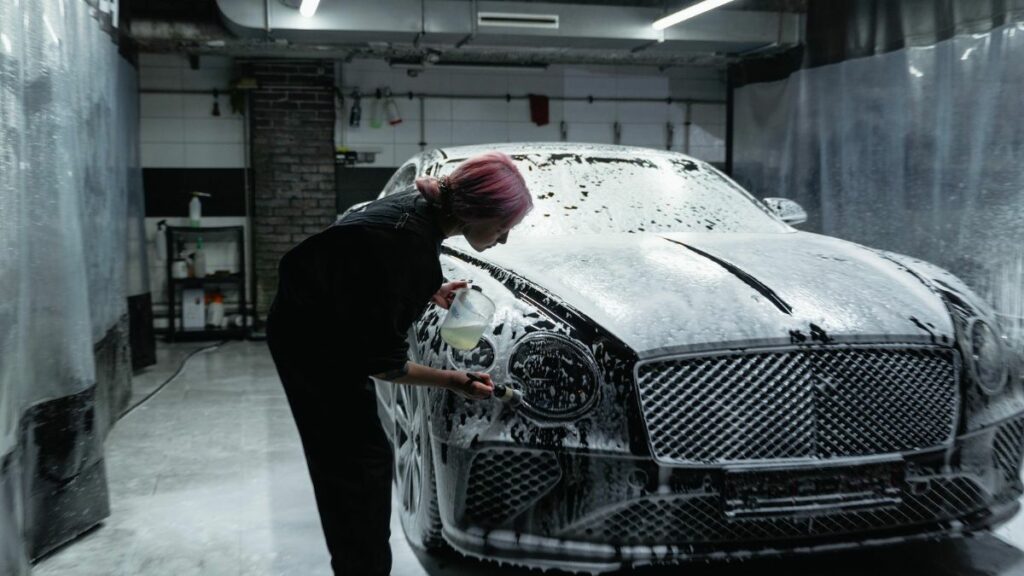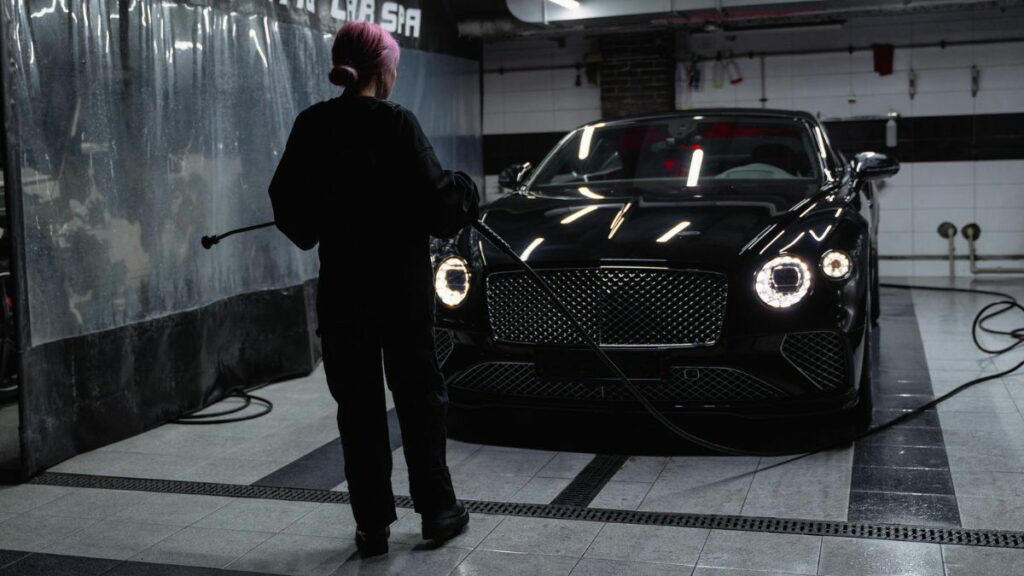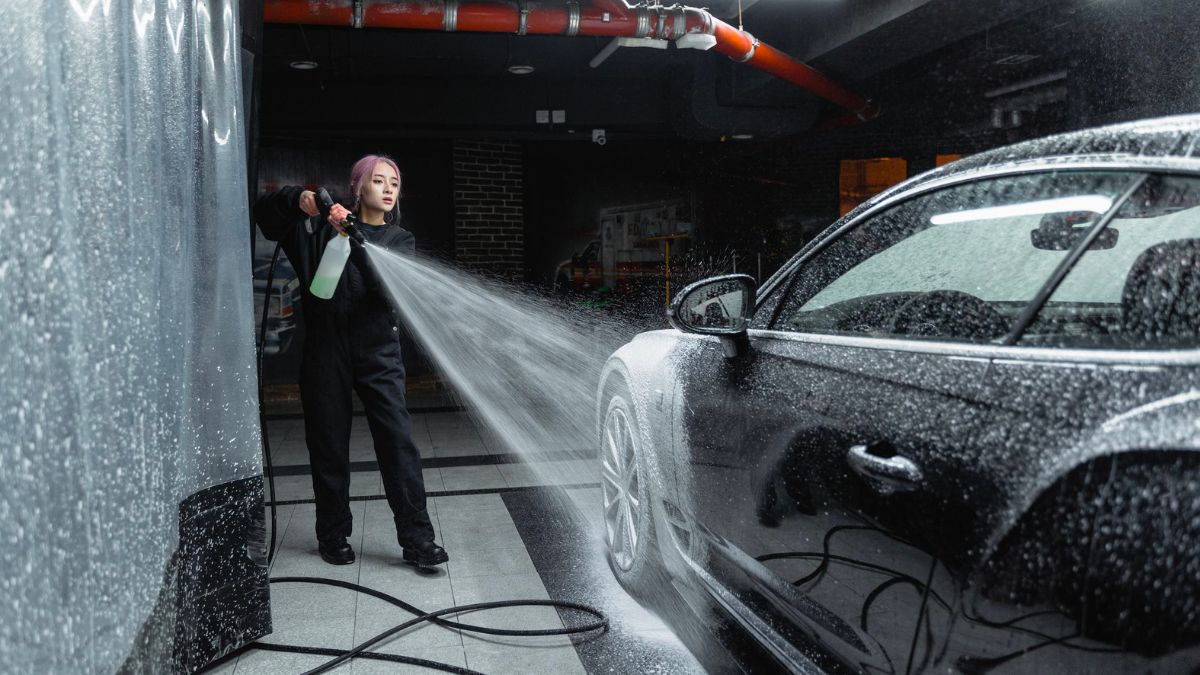A self car wash is a great way to clean your vehicle for a low cost. However, it is important to understand how they operate before you use them.
A self car wash is a garage-like stall where you park your vehicle and then walk around to spray water and soap on the car. They usually also have a brush for cleaning hard to reach areas.
Wash Cycle
A self car wash is an automated system that moves your vehicle through a series of cleaning steps. Each step takes a bit of time, but you decide how long to spend on each one.
The Wash Cycle is the heart of every self car wash. It consists of a combination of high-pressure water jets, a spin cycle, and a sprayer for soap and rinse solutions.
First, you’ll pass through a metal arch fitted with several small nozzles to spray a special pre-soak solution to loosen the dirt on your wheels. This is a crucial step to get rid of sludge and grit before you wash the vehicle.
Second, the machine will dispense the right amount of soap, rinse solution, and wax. This is the best way to make sure your car gets cleaned thoroughly and properly.
Third, you’ll be notified when your car is done with the Wash Cycle. This usually happens in about a minute, but you might need a few extra minutes to get your tires fully dry.
Finally, you’ll be rewarded with a shiny clean car. This is a good time to check your mirrors and windows for any spots that you missed during the washing process.
The Wash Cycle is an impressive feat of technology that enables you to clean your ride in the fastest time possible, while saving you money at the same time. It’s also a great way to give your car a little TLC before you put it back on the road. And the best part is, it’s all on your terms. You can even choose which detergent to use, or if you want to skip the soaking phase and go straight for the wash.
Soap

If you are looking for a good car wash soap, then you need to choose the best one that will provide your vehicle with the proper cleaning and protection. You can find a wide variety of products on the market, but some of them are not ideal for your car, and they contain harsh chemicals that may do more harm than good.
You should also make sure that the product you are using is pH-balanced, and that it will not damage your paint or other delicate parts. The right soap can help you get rid of stubborn stains and dirt, and it will leave your car clean and beautiful.
Some of the best car wash soaps are designed to be used with a bucket and sponge, so you don’t need to hose it down afterward. This helps keep your water bill low, while also making it eco-friendly.
A car wash soap should be able to remove tough mud, road salts, and other contaminants from your vehicle’s surface. Some products will also provide a protective coat to help your paint stay cleaner longer.
To select a car wash soap, you should look for one that is made with quality ingredients and has been tested by real-world customers. This way, you can be assured that it will perform well in your home or at a professional car wash.
In addition, you should check the soap’s lubricity and pH balance, as these factors will determine its long-term performance. If you are looking for a product that is biodegradable, then you should consider buying an organic car wash soap.
The right soap will leave your car with a shine and protection that will last for years. You will be able to avoid costly auto body shops and keep your car looking like new.
Some of the best car wash soaps are available online and at many retailers, so you can choose the right one for your car. These products go through two rounds of reviews and will ensure that you will find the best one for your needs.
Rinse
The rinse is the first step in a process that will get your vehicle sparkling clean and ready to hit the road. You can choose from the usual options like washing your vehicle in water or soap to more specialized offerings such as scrubbing, waxing, or a foamy brush.
The Rinse is a bit of a fad in the car wash industry, but it’s a great way to leave your vehicle looking and smelling fresh and clean. In the right conditions, a rinse will help remove dirt from the wheels and paint, which will improve your vehicle’s appearance.
A rinse is also a great way to remove soap from the interior parts of your car, such as your floor mats, ash tray, and removable storage compartments. It can even remove the smell of cigarette smoke, which is an unpleasant odor that can ruin the look and feel of your interior.
To get a good rinse, you’ll want to use a high-pressure cleaner that will squirt soap around your vehicle, then spritz water on top of the suds. This will agitate the soap and make it more effective at getting rid of dirt.
Next, you’ll want to use a sponge with a nice grip and a hefty lather. You can also opt for an oversized wash mitt. It’s best to have a variety of sizes so you can cover the entire surface of your vehicle without leaving any residue behind.
Using the right tools and equipment can save you time and money in the long run. For example, a premium wash mitt can help you remove more dirt from your vehicle in less time than you might think.
It’s also a good idea to use a quality soap. The wrong kind can do more harm than good, which is why you should invest in a high-quality brand such as GinSan or National Pride.
In short, a rinse is the best way to get your vehicle clean and ready to drive. It’s the one thing you should never skip. It’s the most important part of the entire process, and the only part you can’t mess up.
Wax

Self car washes are an excellent option for the busy driver who doesn’t have time to go to the nearest wash. They offer a wide range of options, including engine and wheel wash, tire cleaners, pre-wash systems and more. These features increase the value of the service and are a great way to get more money from customers.
The most important thing to remember when using a self car wash is that you can’t spray anything that isn’t clean. This includes things like carpet and ashtrays, as well as the removable storage compartments in your car. If you are not careful, the grit that you spray can scratch your car.
Most self car wash units are set up with a few different settings, and each one is meant to be used for a particular purpose. They typically have a “wash”, “soap” and “rinse” setting, with more advanced options available as well, such as engine and wheel cleaning, pre-soak and wax.
Each setting has a variety of settings, including pressure levels, durations and timers. These settings vary from unit to unit, so it is important to learn how the sprayer works before you use it.
It is also a good idea to check the direction of the wind before you begin your washing session, as this can make a big difference in how messy it is and how much soap you end up using. This is a small step, but it will make a big difference in your overall experience at the self car wash.
Finally, it’s a good idea to bring your own brushes and mitts for the wash. This will help you avoid bringing grime and grit onto your vehicle from the brushes that someone else has used before you.
The wax is a water-based product with hydrophobic and gloss-enhancing properties. It is used to improve the sheen and shine of the paint, making it more resistant to scratches. It is applied by spraying it onto the vehicle’s exterior, and then buffing off with a microfiber towel.
Tips For Rinsing and Drying Car Paint
One of the most important steps in detailing your car is drying it correctly. This can make a big difference in how well the paint looks after washing and can also help preserve it.
Many people forget to dry their cars properly and end up with water spots that can be hard to remove. The good news is that this step doesn’t have to be as difficult as it seems.
Rinse
The best way to rinse a car is to remove as much water as possible from the vehicle using either a squeegee or a microfiber towel. A squeegee will primarily remove standing water, while a microfiber will do a better job of absorbing the water as you work your way through the surface.
During the washing process, do your best to concentrate on one section at a time, rinsing it off completely before moving on to the next. This will prevent the soap from getting trapped on the paint.
Once the car is clean, it is time to dry off the vehicle. There are several ways to do this, but some of the more effective methods include a microfiber towel or air blower.
A chamois is another useful tool, and it will help you get the water off of the vehicle’s shiny surfaces. This is because it has a rubber or leather material that helps absorb the water and wipe it off.
When using a chamois, it is important to use it in long, sweeping motions instead of dragging it over the shiny surface. This will ensure that the towel gets a good workout and will help it dry faster.
It is also a good idea to wring out the drying towel periodically, as this will allow it to retain more moisture. In addition, it will prevent the towel from collecting dirt and debris which may scratch the surface of the car.
The best way to dry a car is to remove as much water from the vehicle as possible using either a squeegee, a microfiber towel or an air blower. A squeegee will provide the most results, but a microfiber towel or an air blower will do a better job of removing the water from the shiny surfaces.
Blot
Car washing is an important part of keeping your vehicle looking its best. It helps remove dirt, dust, and other environmental debris that can damage the clear coat of your car. It can be done at home or at a car wash.
It also helps eliminate the build-up of germs and bacteria on your steering wheel and gear shift knobs. Using a disinfecting wipe or a microfiber towel can help you do this effectively.
Blotting is a very important technique to use when trying to remove stains from your car. You want to blot immediately after the spill or stain occurs. This will help you get rid of the liquid that caused the stain and will allow you to rinse it out more effectively.
You can blot the spill with a dry absorbent towel or paper towel. The towel should be white so the colors from the stain won’t run into the towel and onto your car.
This can help you remove the stains from your car more quickly and easily. The blotting method is also helpful in preliminarily drying your car and removing any standing water that may be present on the surface.
Often, it can be difficult to get rid of spotting from your vehicle’s paint after washing it. This happens because the soap you’re using may leave a residue on your paint that can lead to spotting.
To prevent this, try using a soap that’s specifically designed for your car. These soaps have more lubricant in them to create a slick foam that resists abrasions. They’re also pH-balanced, so they’ll break down any scum that’s accumulated on your car.
When you’re doing your car wash, blotting the surfaces of your car with a towel before you spray them will help to reduce the amount of spotting. You can also use a product like The Absorber, a tri-layer microfiber cloth that can be used to blot your car before you spray it with a wax.
During the blotting process, you can use a BBQ skewer to remove dirt and trash from small crevices. You can even place an old sock or a travel cup in the cup holders to remove any trash that has collected there.
Sheet
If you’re looking for ways to save money on car care, one of the best ways is to use household items that you probably already have in your house. For example, a few dryer sheets can freshen the air in your car and help to remove dead bugs from the outside of your vehicle.
Before you begin sheeting your car, it’s important to clean it thoroughly. The first step is to wash down all of the windows and remove any dirt, grime, or dust from them. This will prevent any streaks from forming later on.
Alternatively, you can also use a sponge to wipe down the entire exterior of your car. Make sure to get into the corners and under the hood to make sure all of the dirt is removed from there.
Then, you can use a damp chamois or a microfiber towel to gently and quickly dry the outside of your car. Using high-quality microfiber towels is best, as they will allow you to avoid rubbing the paint and causing scratches.
Once you’ve finished drying your car, it’s time to put the nozzle back on your hose and turn it on with medium pressure. This will cause the water to flow freely over your car and “sheet” off, carrying 80% or more of the surface water with it.
If you’re working on a very dirty car, you may want to skip this step and use a high-quality foam cleaning compound instead. This will ensure that you don’t damage your car’s finish, which is the most important part of the entire process!
Aside from using a soapy solution, it’s also important to keep in mind that there are different types of detergents out there. You should always read the label carefully and use a detergent that is safe for your car’s finish.
You’ll find that some detergents can strip the protective coating on your car’s paint. This is why it’s a good idea to test a small area of your vehicle’s paint before you start to scrub it with a dry sponge or mitt.
Dry
Washing your car properly will remove dirt, grease and grime from the paint surface. However, if you skip drying your vehicle after washing it can cause serious damage to the finish over time. This can lead to scratches, swirls and dulling of the paint.
Drying your car is a vital step in the washing process, but many people neglect this step. Not only does it help the process go faster, but it will also prevent water spots from etching into the paint and damaging it in the long run.
The best way to dry your car is by using a microfiber towel. These towels are specifically designed for drying and will not damage your vehicle’s paint, although they can scratch if the towel is dirty or subjected to excessive heat.
You can also use a chamois or a soft terry towel to blot up the excess water from the paint. This is one of the most common methods used to dry a vehicle, but you should always check that the chamois is pliable and does not pick up any dirt.
Another great way to dry your vehicle is by using an air dryer. This method uses moving air to dry your car, and is arguably the best option as there is no direct contact with the paint. You can choose to use a handheld air blower or invest in a dedicated car drier.
When using an air blower, make sure you start with the top of your vehicle and work your way down to the bottom. This will prevent any extra water that has dripped off the roof from soaking into other areas.
After completing this stage, you can move on to the next area of your car. This is usually the windshield, rear glass and hood. Then, open the doors and wipe down the jambs and seal areas. This will ensure that the exterior of your vehicle is completely dry before you open the doors again.
Then, you can proceed to the next step in your washing and detailing routine. The final step is to detail the interior of your vehicle. The process is relatively easy and requires minimal effort.











